Minerochemical and Microtextural Study of the Ungrouped Iron Meteorite Oglat Sidi Ali, Eastern Highlands, Morocco, and Geomorphological Characterization of Its Strewnfield
Abstract
:1. Introduction
2. Geomorphology of the Oglat Sidi Ali Site
3. The Oglat Sidi Ali Strewnfield
4. Materials and Methods
5. Results and Discussion
5.1. Physical Characteristics
5.2. Textural Features
5.3. Mineral Chemistry
6. Conclusions
Author Contributions
Funding
Data Availability Statement
Acknowledgments
Conflicts of Interest
References
- Ibhi, A.; Nachit, H.; Abia, E.H. Tissint Meteorite: New Mars Meteorite fall in Morocco. J. Mater. Environ. Sci. 2013, 4, 293–298. [Google Scholar]
- Ibhi, A. Morocco meteorite falls and finds: Some statistics. Int. Lett. Chem. Phys. Astron. 2014, 20, 18–24. [Google Scholar] [CrossRef] [Green Version]
- Meteoritical Bulletin Database. Available online: https://www.lpi.usra.edu/meteor/ (accessed on 8 September 2022).
- Bouvier, A.; Gattacceca, J.; Agee, C.; Grossman, J.; Metzler, K. The Meteoritical Bulletin, No. 104. Meteorit. Planet Sci. 2017, 52, 2284. [Google Scholar] [CrossRef] [Green Version]
- Russo, P. Morphologie des Hauts Plateaux Est Maoc. An. Géographie 1947, 56, 36–48. [Google Scholar] [CrossRef]
- Vanié, L.T.A.; Khattach, D.; Houari, M.R. Apport des filtrages des anomalies gravimétriques à l’étude des structures profondes du Maroc oriental. Bull. Inst. Sci. 2005, 27, 29–40. [Google Scholar]
- Abderbi, J.; Khattach, D. Contribution de la gravimétrie à l’étude de la structure des Hauts Plateaux (Maroc oriental). Bull. Inst. Sci. 2010, 32, 19–30. [Google Scholar]
- Médioni, R. Projet de prospection des réservoirs aquifères profonds du Maroc oriental. Notes complementaires sur la campagne de sondages 1969–70 (HP1, HP2, HP3). Serv. Carte Géol. 1972, 14. [Google Scholar]
- Nininger, H.H. Meteorite with Unique Features. Science 1963, 139, 345–347. [Google Scholar] [CrossRef]
- Lorenz, C.A.; Ivanova, M.A.; Artemieva, N.A.; Sadilenko, D.A.; Chennaoui, A.H.; Roschina, I.A.; Korochantsev, A.V.; Humayun, M. Formation of a small impact structure discovered within the Agoudal meteorite strewn field, Morocco. Meteorit. Planet. Sci. 2015, 50, 112–134. [Google Scholar] [CrossRef]
- Fedi, M.E.; Chiari, M.; Giuntini, L.; Lucarelli, F.; Mandò, P.A. The differential PIXE set-up at the Van de Graaff laboratory in Florence. Nucl. Instrum. Methods Phys. Res. B 2002, 189, 56–61. [Google Scholar] [CrossRef]
- Goldstein, J.I.; Michael, J.R. The formation of plessite in meteoritic metal. Meteorit. Planet. Sci. 2006, 41, 553–570. [Google Scholar] [CrossRef]
- Wang, N.; Wang, G.; Zhang, T.; Gu, L.; Zhang, C.; Hu, S.; Miao, B.; Lin, Y. Metallographic cooling rate and petrogenesis of the recently found Huoyanshan iron meteorite shower. J. Geophys. Res. Planets 2021, 126, e2021JE006847. [Google Scholar] [CrossRef]
- Yang, J.; Goldstein, J.I.; Scott, E.R.D.; Michael, J.R.; Kotula, P.G.; Pham, T.; McCoy, T.J. Thermal and impact histories of reheated group IVA, IVB, and ungrouped iron meteorites and their parent asteroids. Meteorit. Planet. Sci. 2011, 46, 1227–1252. [Google Scholar] [CrossRef]
- Jones, J.H.; Ross, D.K.; Chabot, N.L.; Keller, L.P. Implications for metallographic cooling rates, derived from fine-scale analytical traverses across kamacite, taenite, and tetrataenite in the Butler iron meteorite. In Proceedings of the 2016 47th Lunar and Planetary Science Conference, The Woodlands, TX, USA, 21–25 March 2016; LPI Contribution No. 1903. p. 2432. [Google Scholar]
- Grady, M.; Pratesi, G.; Moggi Cecchi, V. Atlas of Meteorites; Cambridge University Press: Cambridge, UK, 2014; p. 384. [Google Scholar]
- D’Orazio, M. Petrography, geochemistry and classification of ten new iron meteorites from Northwest Africa and Chile. Period. Mineral. 2020, 89, 3–18. [Google Scholar]
- Moggi Cecchi, V.; Caporali, S.; Pratesi, G.; Nachit, H.; Herd, C.D.K.; Chen, G. Compositional and textural data of a new ungrouped iron meteorite from Oglat Sidi Ali, Morocco. In Proceedings of the European Planetary Science Congress, Nantes, France, 27 September–2 October 2015; Abstracts, Volume 10. pp. 312–314. [Google Scholar]
- Bouvier, A.; Gattacceca, J.; Grossman, J.; Metzler, K. The Meteoritical Bulletin, No. 105. Meteorit. Planet. Sci. 2017, 52, 2411. [Google Scholar] [CrossRef]
- Wasson, J.T. Relationship between iron-meteorite composition and size: Compositional distribution of irons from North Africa. Geochim. Cosmochim. Acta 2011, 75, 1757–1772. [Google Scholar] [CrossRef]
- Goldstein, J.I. Butler, Missouri: An Unusual Iron Meteorite. Science 1966, 153, 975–976. [Google Scholar] [CrossRef] [Green Version]
- Buchwald, V.F. Handbook of Iron Meteorites; University of California Press: Auckland, CA, USA, 1975; p. 1418. [Google Scholar]
- Ruzicka, A.; Grossman, J.; Bouvier, A.; Herd, C.D.; Agee, C.B. The Meteoritical Bulletin, No. 101. Meteorit. Planet. Sci. 2015, 50, 1661. [Google Scholar] [CrossRef]
- D’Orazio, M.; Folco, L. Chemical analysis of iron meteorites by inductively coupled plasma-mass spectrometry. Geostand. Newslett. 2003, 27, 215–225. [Google Scholar] [CrossRef]
- Bischoff, A.; Geiger, T. Meteorites from the Sahara: Find locations, shock classification, degree of weathering and pairing. Meteorit. Planet. Sci. 1995, 30, 113–122. [Google Scholar] [CrossRef]
- Folco, L.; Di Martino, M.; El Barkooky, A.; D’Orazio, M.; Lethy, A.; Urbini, S.; Nicolosi, I.; Hafez, M.; Cordier, C.; Van Ginneken, M.; et al. Kamil Crater (Egypt): Ground truth for small-scale meteorite impacts on Earth. Geology 2011, 39, 179–182. [Google Scholar] [CrossRef]
- Newman, J.D.; Herd, C.D.K. Mineralogy, petrology, and distribution of meteorites at the Whitecourt crater, Alberta, Canada. Meteorit. Planet. Sci. 2015, 50, 305–317. [Google Scholar] [CrossRef]
- Nachit, H.; Abia, E.; Bonadiman, C.; Di Martino, M.; Vaccaro, C. The preservation of the Agoudal impact crater, Morocco, under a landslide: Indication of a genetic link between shatter cones and meteorite fragments. Geomorphology 2017, 295, 76–83. [Google Scholar] [CrossRef]
- Jull, A.J.T. Terrestrial ages of meteorites. In Accretion of Extraterrestrial Matter through Earth’s History; Peucker-Ehrenbrink, B., Schmitz, B., Eds.; Kluwer Acadamic/PlenumPublisher: New York, NY, USA, 2001; pp. 241–266. [Google Scholar]
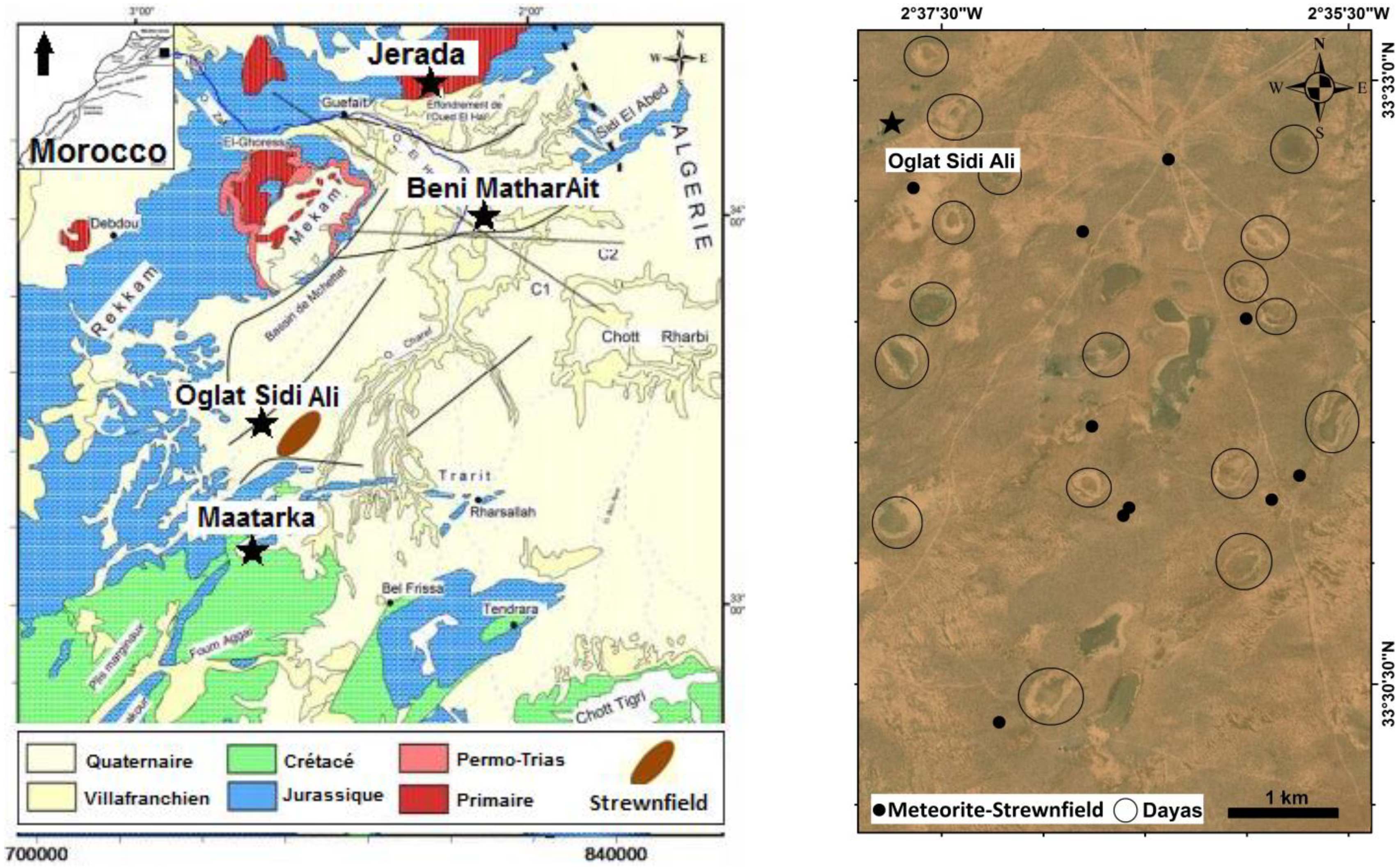


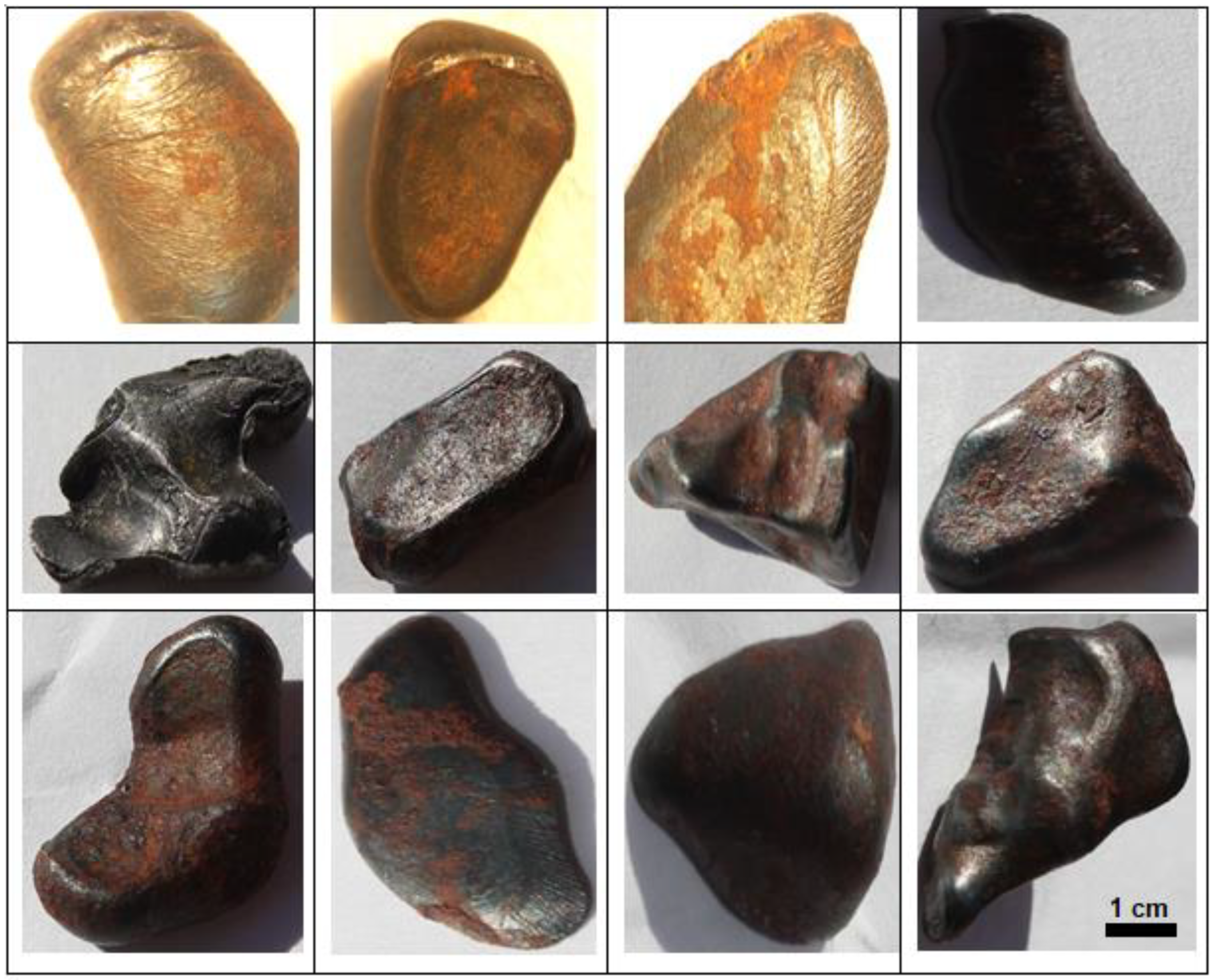
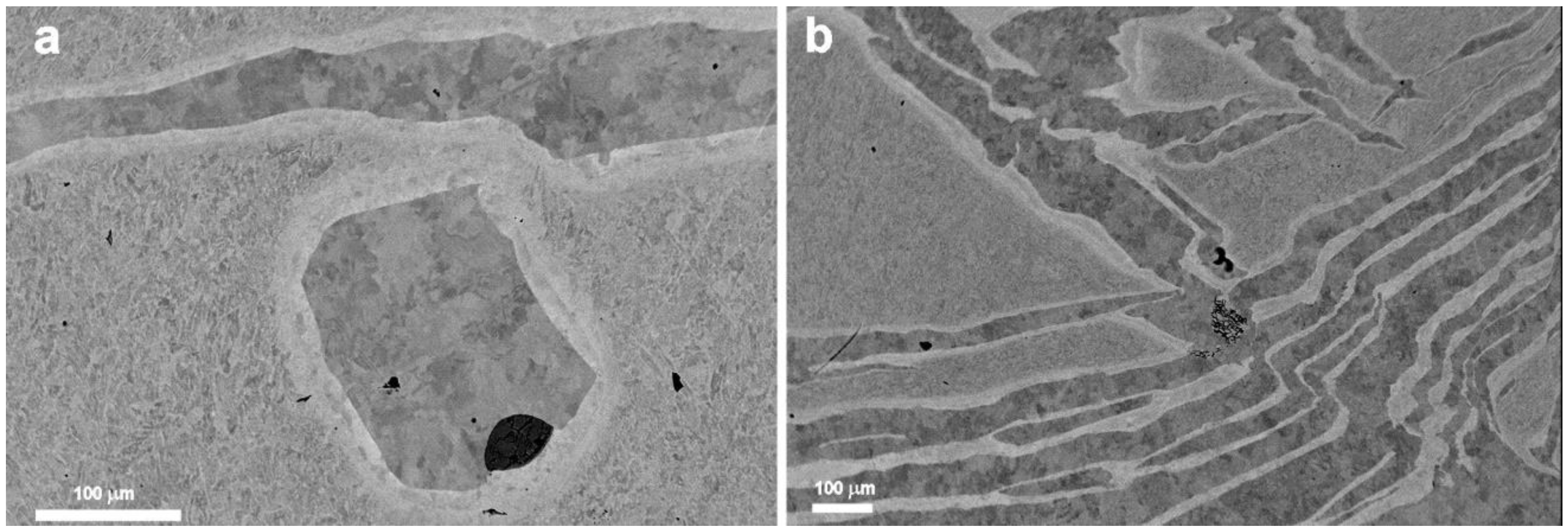
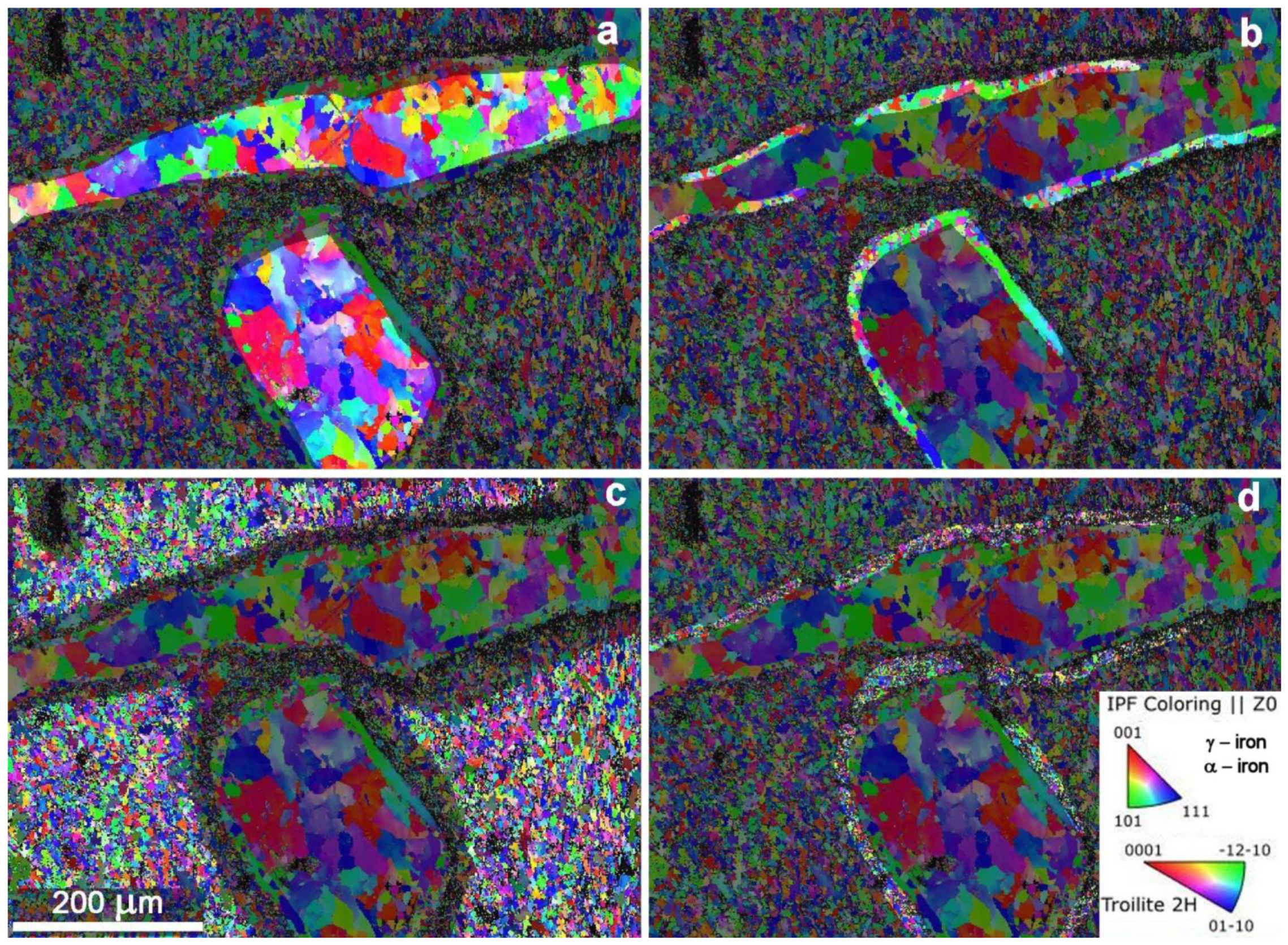
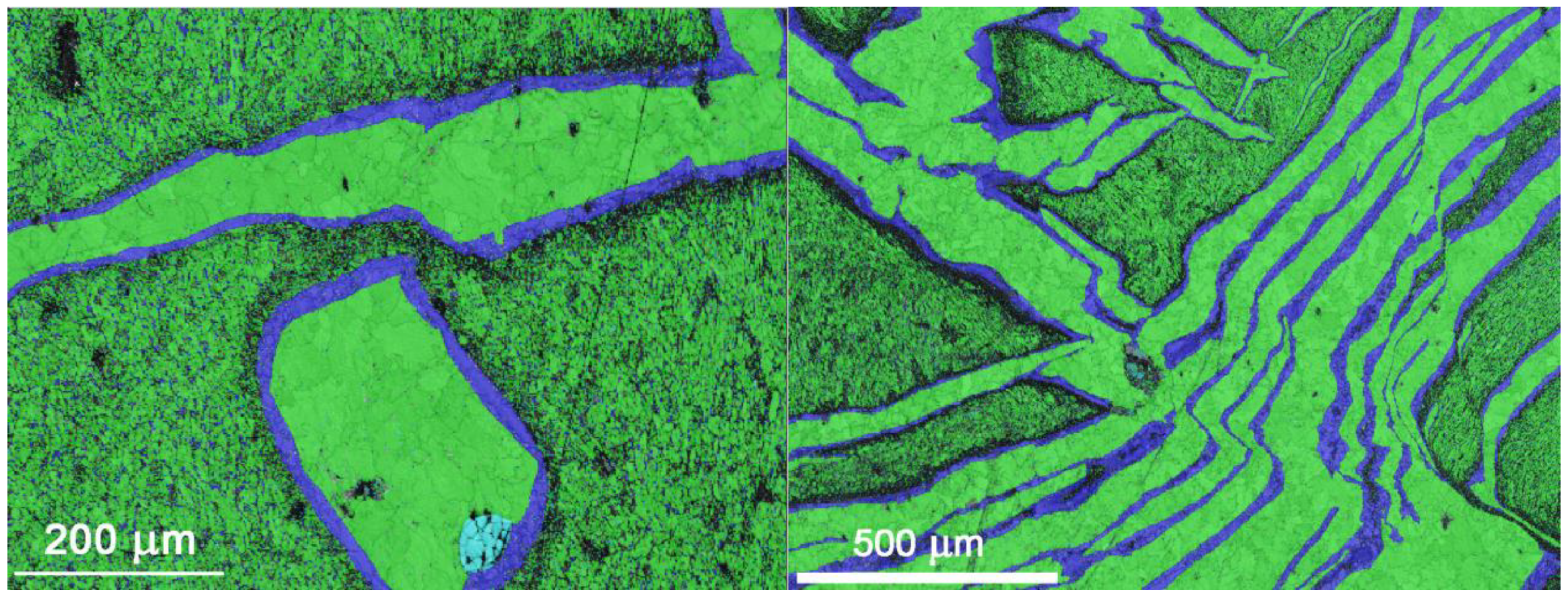


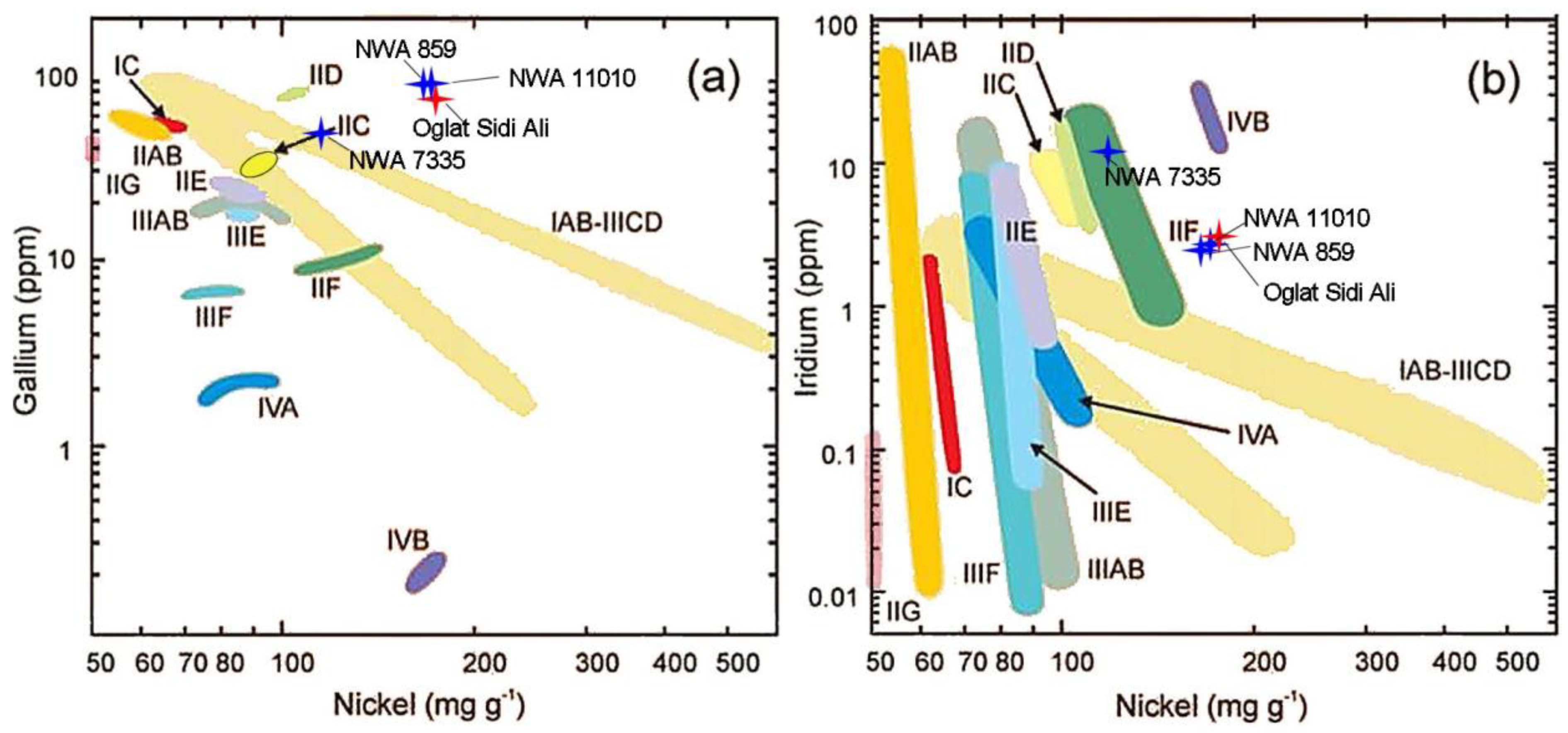
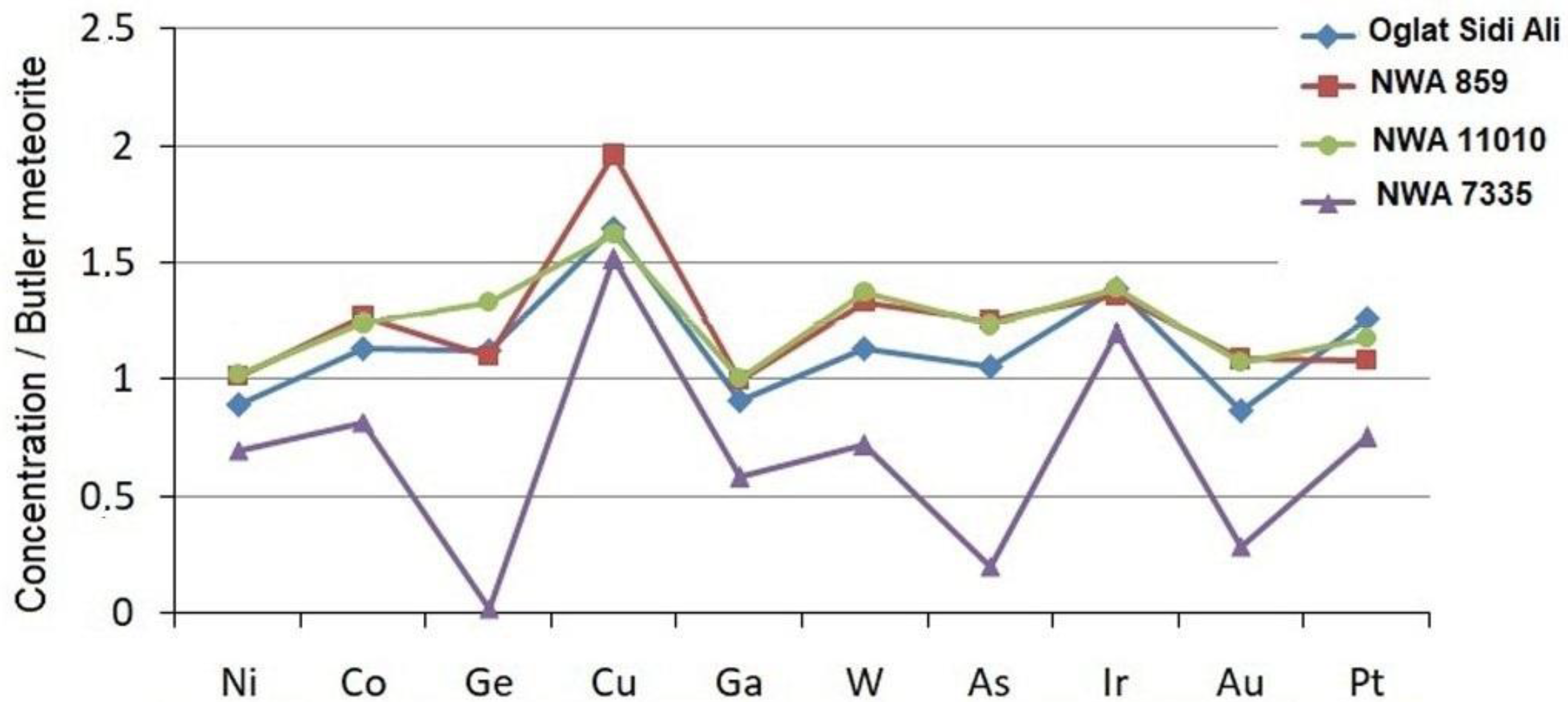

| Year | Meteorite Characterizations | GPS Coordinates |
|---|---|---|
| 1998 | Three specimens weighing about 1 kg were collected in this area by a nomad who sold them to a dealer in Oujda. | 33°29′46.5″ N, 02°36′27.6″ W 33°32′44.1″ N, 02°36′22.4″ W 33°31′20.6″ N, 02°36′26.1″ W |
| 2001–2005 | The meteorite hunters conducted a systematic search with the aid of metal detectors:
| 33°36′5.7″ N, 02°34′54.6″ W 33°31′15.3″ N, 02°34′33.4″ W 33°33′12.9″ N, 02°34′58.8″ W 33°30′16.8″ N, 02°36′47.3″ W 33°31′21.4″ N, 02°36′25.3″ W 33°30′14.0″ N, 02°36′39.8″ W 33°26′55.7″ N, 02°39′36.1″ W |
| 2012 | A single mass of approximately 139 kg was recovered from a depth of about 60 cm. | 33°28′01.0″ N, 02°39′17.2″ W |
| 2013, 2014, 2015 and 2017 | Four fieldwork expeditions were conducted by some of the authors with the aid of a metal detector and the collaboration of dozens of nomads and dealers to get information about old finds, collect new fragments (Figure 3 and Figure 4), and define the size of the strewnfield and the direction of the fall. | 33°31′33.1″ N, 02°36′24.8″ W 33°31′39.2″ N, 02°36′34.8″ W 33°31′54.1″ N, 02°36′39.2″ W 33°32′12.0″ N, 02°36′33.8″ W 33°31′59.2″ N, 02°35′27.9″ W 33°33′29″ N, 02°35′59.2″ W 33°29′58.7″ N, 02°36′25.1″ W |
| Data Set (Figure 6) | Grain Size | Main Phase | Avg. Area (μm2) | Max. Area (μm2) | Grain Counts |
|---|---|---|---|---|---|
| 8a | Coarse | Kamacite | 35.6 | 1987.4 | 1153 |
| 8b | Medium | Taenite | 8.5 | 179.1 | 1175 |
| 8c | Fine | Plessitic texture | 6.5 | 120.0 | 19819 |
| 8d | Extrafine | Plessitic texture | 2.9 | 37.2 | 3514 |
| Elements | Raster Analyses on 500 × 400 µm-Wide Areas (SEM-EDX) | Kamacite | Taenite | Ni-Rich Taenite | Plessitic Texture | Plessitic Texture | Troilite | Nickel-Phosphide |
|---|---|---|---|---|---|---|---|---|
| N° of analyses | 9 | 20 | 21 | 9 | 6 | 20 | 3 | 3 |
| Selected Area | - | Coarse-grained | Medium-grained | Medium-grained | Extrafine-grained | Fine-grained | - | - |
| Fe | 81.98 | 90.47 | 72.13 | 58.49 | 80.19 | 82.34 | 61.17 | 34.93 |
| Co | 1.72 | 1.61 | 1.26 | 0.62 | 1.42 | 1.39 | 0.47 | 0.43 |
| Ni | 15.98 | 6.17 | 24.49 | 39.02 | 16.05 | 14.40 | 0.41 | 48.12 |
| Ge | 0.25 | 0.18 | 0.24 | 0.39 | 0.13 | 0.17 | --- | --- |
| Cu | --- | --- | 0.06 | 0.10 | 0.03 | 0.03 | --- | --- |
| Si | --- | --- | --- | --- | --- | --- | --- | 0.11 |
| P | --- | --- | --- | --- | --- | --- | 0.13 | 16.40 |
| S | --- | --- | --- | --- | --- | --- | 37.72 | --- |
| Cr | --- | --- | --- | --- | --- | --- | 0.12 | --- |
| Total | 99.93 | 98.45 | 98.19 | 98.64 | 97.83 | 98.34 | 100.02 | 99.99 |
| Elements Meteorites | Ni (mg/g) | Co (mg/g) | Ge (μg/g) | Cu (μg/g) | Ga (μg/g) | As (μg/g) | W (μg/g) | Ir (μg/g) | Pt (μg/g) | Au (μg/g) |
|---|---|---|---|---|---|---|---|---|---|---|
| Oglat Sidi Ali | 163.4 | 12.2 | 2256 * | 325.7 | 79.2 | 45.4 | 6.7 | 3.3 | 45.3 | 5.2 |
| NWA 859 | 159.3 | 13.1 | 2200 | 296.1 | 87.0 | 54.2 | 6.8 | 2.5 | 37.7 | 6.5 |
| NWA 11010 | 160.7 | 12.8 | 2666 | 245.2 | 87.5 | 53.3 | 7.0 | 2.5 | 41.0 | 6.5 |
| Butler | 157.2 | 10.3 | 2000 | 151.1 | 87.1 | 48.2 | 5.1 | 1.8 | 34.9 | 6.8 |
| NWA 7335 | 109.8 | 8.4 | 41.2 | 229 | 50.8 | 8.7 | 3.7 | 12.3 | 26.3 | 1.7 |
Publisher’s Note: MDPI stays neutral with regard to jurisdictional claims in published maps and institutional affiliations. |
© 2022 by the authors. Licensee MDPI, Basel, Switzerland. This article is an open access article distributed under the terms and conditions of the Creative Commons Attribution (CC BY) license (https://creativecommons.org/licenses/by/4.0/).
Share and Cite
Nachit, H.; Ibhi, A.; En-nasiry, M.; Moggi Cecchi, V.; Pratesi, G.; Herd, C.D.K.; Senesi, G.S. Minerochemical and Microtextural Study of the Ungrouped Iron Meteorite Oglat Sidi Ali, Eastern Highlands, Morocco, and Geomorphological Characterization of Its Strewnfield. Minerals 2022, 12, 1470. https://doi.org/10.3390/min12111470
Nachit H, Ibhi A, En-nasiry M, Moggi Cecchi V, Pratesi G, Herd CDK, Senesi GS. Minerochemical and Microtextural Study of the Ungrouped Iron Meteorite Oglat Sidi Ali, Eastern Highlands, Morocco, and Geomorphological Characterization of Its Strewnfield. Minerals. 2022; 12(11):1470. https://doi.org/10.3390/min12111470
Chicago/Turabian StyleNachit, Hassane, Abderrahmane Ibhi, Mohamed En-nasiry, Vanni Moggi Cecchi, Giovanni Pratesi, Christopher D. K. Herd, and Giorgio S. Senesi. 2022. "Minerochemical and Microtextural Study of the Ungrouped Iron Meteorite Oglat Sidi Ali, Eastern Highlands, Morocco, and Geomorphological Characterization of Its Strewnfield" Minerals 12, no. 11: 1470. https://doi.org/10.3390/min12111470







